Yadan Luo
Are Synthetic Videos Useful? A Benchmark for Retrieval-Centric Evaluation of Synthetic Videos
Jul 03, 2025Abstract:Text-to-video (T2V) synthesis has advanced rapidly, yet current evaluation metrics primarily capture visual quality and temporal consistency, offering limited insight into how synthetic videos perform in downstream tasks such as text-to-video retrieval (TVR). In this work, we introduce SynTVA, a new dataset and benchmark designed to evaluate the utility of synthetic videos for building retrieval models. Based on 800 diverse user queries derived from MSRVTT training split, we generate synthetic videos using state-of-the-art T2V models and annotate each video-text pair along four key semantic alignment dimensions: Object \& Scene, Action, Attribute, and Prompt Fidelity. Our evaluation framework correlates general video quality assessment (VQA) metrics with these alignment scores, and examines their predictive power for downstream TVR performance. To explore pathways of scaling up, we further develop an Auto-Evaluator to estimate alignment quality from existing metrics. Beyond benchmarking, our results show that SynTVA is a valuable asset for dataset augmentation, enabling the selection of high-utility synthetic samples that measurably improve TVR outcomes. Project page and dataset can be found at https://jasoncodemaker.github.io/SynTVA/.
WisWheat: A Three-Tiered Vision-Language Dataset for Wheat Management
Jun 06, 2025Abstract:Wheat management strategies play a critical role in determining yield. Traditional management decisions often rely on labour-intensive expert inspections, which are expensive, subjective and difficult to scale. Recently, Vision-Language Models (VLMs) have emerged as a promising solution to enable scalable, data-driven management support. However, due to a lack of domain-specific knowledge, directly applying VLMs to wheat management tasks results in poor quantification and reasoning capabilities, ultimately producing vague or even misleading management recommendations. In response, we propose WisWheat, a wheat-specific dataset with a three-layered design to enhance VLM performance on wheat management tasks: (1) a foundational pretraining dataset of 47,871 image-caption pairs for coarsely adapting VLMs to wheat morphology; (2) a quantitative dataset comprising 7,263 VQA-style image-question-answer triplets for quantitative trait measuring tasks; and (3) an Instruction Fine-tuning dataset with 4,888 samples targeting biotic and abiotic stress diagnosis and management plan for different phenological stages. Extensive experimental results demonstrate that fine-tuning open-source VLMs (e.g., Qwen2.5 7B) on our dataset leads to significant performance improvements. Specifically, the Qwen2.5 VL 7B fine-tuned on our wheat instruction dataset achieves accuracy scores of 79.2% and 84.6% on wheat stress and growth stage conversation tasks respectively, surpassing even general-purpose commercial models such as GPT-4o by a margin of 11.9% and 34.6%.
CodeMerge: Codebook-Guided Model Merging for Robust Test-Time Adaptation in Autonomous Driving
May 22, 2025



Abstract:Maintaining robust 3D perception under dynamic and unpredictable test-time conditions remains a critical challenge for autonomous driving systems. Existing test-time adaptation (TTA) methods often fail in high-variance tasks like 3D object detection due to unstable optimization and sharp minima. While recent model merging strategies based on linear mode connectivity (LMC) offer improved stability by interpolating between fine-tuned checkpoints, they are computationally expensive, requiring repeated checkpoint access and multiple forward passes. In this paper, we introduce CodeMerge, a lightweight and scalable model merging framework that bypasses these limitations by operating in a compact latent space. Instead of loading full models, CodeMerge represents each checkpoint with a low-dimensional fingerprint derived from the source model's penultimate features and constructs a key-value codebook. We compute merging coefficients using ridge leverage scores on these fingerprints, enabling efficient model composition without compromising adaptation quality. Our method achieves strong performance across challenging benchmarks, improving end-to-end 3D detection 14.9% NDS on nuScenes-C and LiDAR-based detection by over 7.6% mAP on nuScenes-to-KITTI, while benefiting downstream tasks such as online mapping, motion prediction and planning even without training. Code and pretrained models are released in the supplementary material.
Local Information Matters: Inference Acceleration For Grounded Conversation Generation Models Through Adaptive Local-Aware Token Pruning
Apr 01, 2025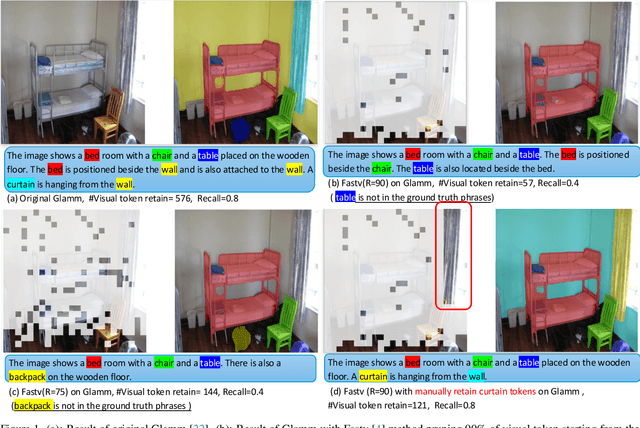
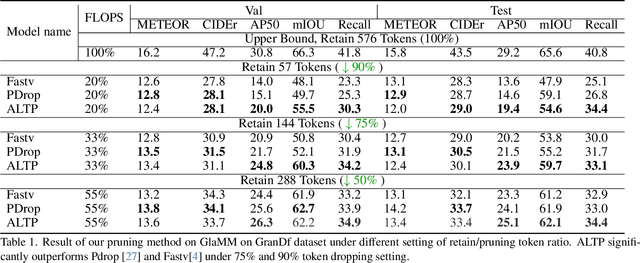
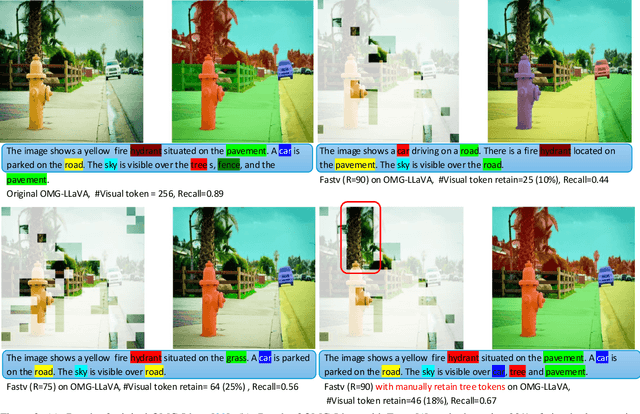

Abstract:Grounded Conversation Generation (GCG) is an emerging vision-language task that requires models to generate natural language responses seamlessly intertwined with corresponding object segmentation masks. Recent models, such as GLaMM and OMG-LLaVA, achieve pixel-level grounding but incur significant computational costs due to processing a large number of visual tokens. Existing token pruning methods, like FastV and PyramidDrop, fail to preserve the local visual features critical for accurate grounding, leading to substantial performance drops in GCG tasks. To address this, we propose Adaptive Local-Aware Token Pruning (ALTP), a simple yet effective framework that accelerates GCG models by prioritizing local object information. ALTP introduces two key components: (1) Detail Density Capture (DDC), which uses superpixel segmentation to retain tokens in object-centric regions, preserving fine-grained details, and (2) Dynamic Density Formation (DDF), which dynamically allocates tokens based on information density, ensuring higher retention in semantically rich areas. Extensive experiments on the GranDf dataset demonstrate that ALTP significantly outperforms existing token pruning methods, such as FastV and PyramidDrop, on both GLaMM and OMG-LLaVA models. Notably, when applied to GLaMM, ALTP achieves a 90% reduction in visual tokens with a 4.9% improvement in AP50 and a 5.0% improvement in Recall compared to PyramidDrop. Similarly, on OMG-LLaVA, ALTP improves AP by 2.1% and mIOU by 3.0% at a 90% token reduction compared with PDrop.
SCORE: Soft Label Compression-Centric Dataset Condensation via Coding Rate Optimization
Mar 18, 2025Abstract:Dataset Condensation (DC) aims to obtain a condensed dataset that allows models trained on the condensed dataset to achieve performance comparable to those trained on the full dataset. Recent DC approaches increasingly focus on encoding knowledge into realistic images with soft labeling, for their scalability to ImageNet-scale datasets and strong capability of cross-domain generalization. However, this strong performance comes at a substantial storage cost which could significantly exceed the storage cost of the original dataset. We argue that the three key properties to alleviate this performance-storage dilemma are informativeness, discriminativeness, and compressibility of the condensed data. Towards this end, this paper proposes a \textbf{S}oft label compression-centric dataset condensation framework using \textbf{CO}ding \textbf{R}at\textbf{E} (SCORE). SCORE formulates dataset condensation as a min-max optimization problem, which aims to balance the three key properties from an information-theoretic perspective. In particular, we theoretically demonstrate that our coding rate-inspired objective function is submodular, and its optimization naturally enforces low-rank structure in the soft label set corresponding to each condensed data. Extensive experiments on large-scale datasets, including ImageNet-1K and Tiny-ImageNet, demonstrate that SCORE outperforms existing methods in most cases. Even with 30$\times$ compression of soft labels, performance decreases by only 5.5\% and 2.7\% for ImageNet-1K with IPC 10 and 50, respectively. Code will be released upon paper acceptance.
TT-GaussOcc: Test-Time Compute for Self-Supervised Occupancy Prediction via Spatio-Temporal Gaussian Splatting
Mar 11, 2025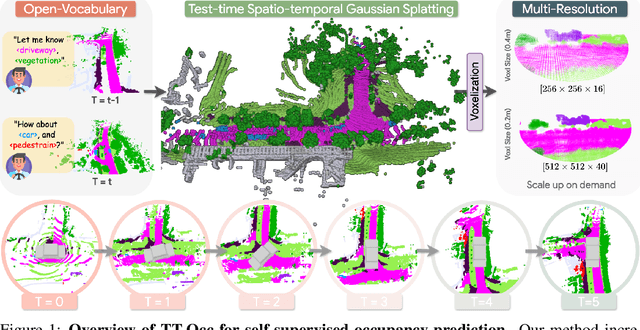


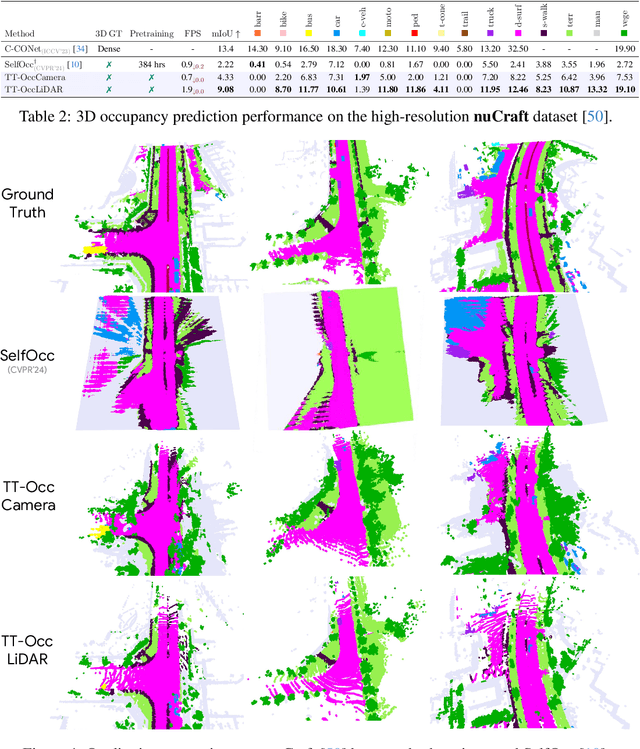
Abstract:Self-supervised 3D occupancy prediction offers a promising solution for understanding complex driving scenes without requiring costly 3D annotations. However, training dense voxel decoders to capture fine-grained geometry and semantics can demand hundreds of GPU hours, and such models often fail to adapt to varying voxel resolutions or new classes without extensive retraining. To overcome these limitations, we propose a practical and flexible test-time occupancy prediction framework termed TT-GaussOcc. Our approach incrementally optimizes time-aware 3D Gaussians instantiated from raw sensor streams at runtime, enabling voxelization at arbitrary user-specified resolution. Specifically, TT-GaussOcc operates in a "lift-move-voxel" symphony: we first "lift" surrounding-view semantics obtained from 2D vision foundation models (VLMs) to instantiate Gaussians at non-empty 3D space; Next, we "move" dynamic Gaussians from previous frames along estimated Gaussian scene flow to complete appearance and eliminate trailing artifacts of fast-moving objects, while accumulating static Gaussians to enforce temporal consistency; Finally, we mitigate inherent noises in semantic predictions and scene flow vectors by periodically smoothing neighboring Gaussians during optimization, using proposed trilateral RBF kernels that jointly consider color, semantic, and spatial affinities. The historical static and current dynamic Gaussians are then combined and voxelized to generate occupancy prediction. Extensive experiments on Occ3D and nuCraft with varying voxel resolutions demonstrate that TT-GaussOcc surpasses self-supervised baselines by 46% on mIoU without any offline training, and supports finer voxel resolutions at 2.6 FPS inference speed.
Don't Shake the Wheel: Momentum-Aware Planning in End-to-End Autonomous Driving
Mar 05, 2025Abstract:End-to-end autonomous driving frameworks enable seamless integration of perception and planning but often rely on one-shot trajectory prediction, which may lead to unstable control and vulnerability to occlusions in single-frame perception. To address this, we propose the Momentum-Aware Driving (MomAD) framework, which introduces trajectory momentum and perception momentum to stabilize and refine trajectory predictions. MomAD comprises two core components: (1) Topological Trajectory Matching (TTM) employs Hausdorff Distance to select the optimal planning query that aligns with prior paths to ensure coherence;(2) Momentum Planning Interactor (MPI) cross-attends the selected planning query with historical queries to expand static and dynamic perception files. This enriched query, in turn, helps regenerate long-horizon trajectory and reduce collision risks. To mitigate noise arising from dynamic environments and detection errors, we introduce robust instance denoising during training, enabling the planning model to focus on critical signals and improve its robustness. We also propose a novel Trajectory Prediction Consistency (TPC) metric to quantitatively assess planning stability. Experiments on the nuScenes dataset demonstrate that MomAD achieves superior long-term consistency (>=3s) compared to SOTA methods. Moreover, evaluations on the curated Turning-nuScenes shows that MomAD reduces the collision rate by 26% and improves TPC by 0.97m (33.45%) over a 6s prediction horizon, while closedloop on Bench2Drive demonstrates an up to 16.3% improvement in success rate.
Provable Ordering and Continuity in Vision-Language Pretraining for Generalizable Embodied Agents
Feb 03, 2025Abstract:Pre-training vision-language representations on human action videos has emerged as a promising approach to reduce reliance on large-scale expert demonstrations for training embodied agents. However, prior methods often employ time contrastive learning based on goal-reaching heuristics, progressively aligning language instructions from the initial to the final frame. This overemphasis on future frames can result in erroneous vision-language associations, as actions may terminate early or include irrelevant moments in the end. To address this issue, we propose Action Temporal Coherence Learning (AcTOL) to learn ordered and continuous vision-language representations without rigid goal-based constraint. AcTOL treats a video as a continuous trajectory where it (1) contrasts semantic differences between frames to reflect their natural ordering, and (2) imposes a local Brownian bridge constraint to ensure smooth transitions across intermediate frames. Extensive imitation learning experiments across varying numbers of demonstrations show that the pretrained features significantly enhance downstream manipulation tasks by up to 49% with high robustness to different linguistic styles of instructions, offering a viable pathway toward generalized embodied agents. The source code is included in the supplementary material for reference.
PolaFormer: Polarity-aware Linear Attention for Vision Transformers
Jan 25, 2025Abstract:Linear attention has emerged as a promising alternative to softmax-based attention, leveraging kernelized feature maps to reduce complexity from quadratic to linear in sequence length. However, the non-negative constraint on feature maps and the relaxed exponential function used in approximation lead to significant information loss compared to the original query-key dot products, resulting in less discriminative attention maps with higher entropy. To address the missing interactions driven by negative values in query-key pairs, we propose a polarity-aware linear attention mechanism that explicitly models both same-signed and opposite-signed query-key interactions, ensuring comprehensive coverage of relational information. Furthermore, to restore the spiky properties of attention maps, we provide a theoretical analysis proving the existence of a class of element-wise functions (with positive first and second derivatives) that can reduce entropy in the attention distribution. For simplicity, and recognizing the distinct contributions of each dimension, we employ a learnable power function for rescaling, allowing strong and weak attention signals to be effectively separated. Extensive experiments demonstrate that the proposed PolaFormer improves performance on various vision tasks, enhancing both expressiveness and efficiency by up to 4.6%.
Color-Oriented Redundancy Reduction in Dataset Distillation
Nov 18, 2024Abstract:Dataset Distillation (DD) is designed to generate condensed representations of extensive image datasets, enhancing training efficiency. Despite recent advances, there remains considerable potential for improvement, particularly in addressing the notable redundancy within the color space of distilled images. In this paper, we propose AutoPalette, a framework that minimizes color redundancy at the individual image and overall dataset levels, respectively. At the image level, we employ a palette network, a specialized neural network, to dynamically allocate colors from a reduced color space to each pixel. The palette network identifies essential areas in synthetic images for model training and consequently assigns more unique colors to them. At the dataset level, we develop a color-guided initialization strategy to minimize redundancy among images. Representative images with the least replicated color patterns are selected based on the information gain. A comprehensive performance study involving various datasets and evaluation scenarios is conducted, demonstrating the superior performance of our proposed color-aware DD compared to existing DD methods. The code is available at \url{https://github.com/KeViNYuAn0314/AutoPalette}.
 Add to Chrome
Add to Chrome Add to Firefox
Add to Firefox Add to Edge
Add to Edge